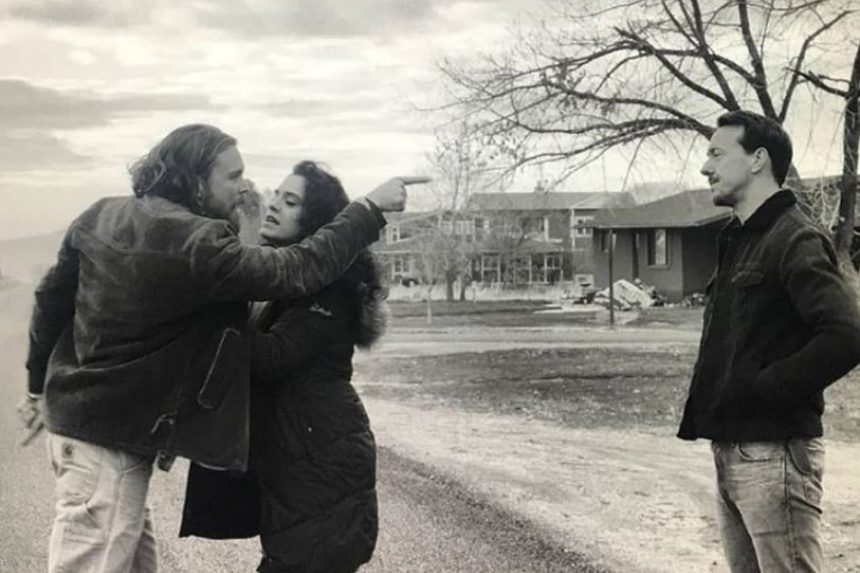The Killing of Two Lovers
⭐ ⭐ ⭐ ⭐
Rating: R
Run Time: 1 hour 25 minutes
Stars: Clayne Crawford, Sepideh Moafi, Chris Coy
Writer/Director: Robert Machoian
In Theaters
Cinema doesn’t get much more intimate than The Killing of Two Lovers, a film that draws us into the lives of a young Utah couple living apart while they struggle to recalibrate their relationship and parent their four children.
You could be forgiven for mistaking writer/director/editor Robert Machoian’s movie for a documentary. Alternating between excruciatingly tight close-ups and wide shots that render human figures little more than features of the landscape, he follows the bearded, overall-clad David (Clayne Crawford of TV’s Lethal Weapon) through his daily Purgatory of loneliness — stealing moments with his three young sons and teenage daughter, engaging in fruitless front-yard conversations with his estranged wife Nikki (The Deuce’s Sepideh Moafi), working odd jobs that make “menial labor” seem like something to aspire to.
Through it all, David forges on with one crystalline goal: To find a way back with Nikki, who seems to be negotiating a premature midlife crisis, questioning specifically whether or not she wants to stay with the man she married out of high school and with whom she had an almost instant family.
“I love you, you love me,” she tells him in one of those supremely unsatisfactory front-yard encounters. “We’re trying to figure this out.”
Unfortunately, while David remains permanently smitten, for Nikki “figuring this out” includes having an affair with a considerably more clean-cut co-worker (Moafi’s costar from The Deuce, Chris Coy). It’s almost too much for David to bear. In the privacy of his room at his father’s house, he screams and pounds the walls. He drags a tackling dummy out to the wilderness and empties a revolver into it — twice. But he also puts on a brave, goofy dad face for his kids (wonderfully played by a batch of actual siblings) and still manages a jaunty wave to the townsfolk, all of whom seem to know everyone’s names…plus their personal problems.
The immediacy of The Killing of Two Lovers is largely due to Machoian’s decision to leave in all the moments other films skip. In the aftermath of a positively chilling opening scene — in which David, shakily fingering a handgun, looms for an agonizing eternity over the bed where his wife and her lover are sleeping — David runs all the way across town to the place where he’s now living with his father. The camera stays with him every step of the way, establishing from the start not only the main character’s frenzied state of mind, but also the physical geography of the film’s setting. This is no man’s land, inside and out. Likewise, we take more than one real-time ridealong in David’s truck, watching the landscape roll by, searching his profile for hints of what is going on in his mind…or what he will do next.
Significantly, even though the distant, dramatic mountains of Utah lend themselves to a wide screen — and, indeed, form a backdrop for nearly every exterior shot — Machoian has chosen to shoot The Killing of Two Lovers in a square frame format. It’s a perfect setting for this jewel of a film; a constant, claustrophobic reminder of how David’s world is crushing in on him.
Indeed, Machoian seems to owe a lot to filmmaker David Lowery, whose minor 2017 classic A Ghost Story similarly utilized the squared-off frame and dreamy, nearly endless, single takes. Perhaps the film’s longest shot — of nothing more than a dad-and-kids outing to a local park to shoot off rockets — goes on for more than five minutes. The director places us fifty yards or so away, forcing us to stand there and simply observe a tableau that, in real life, we might glance at in passing, then forget. Aside from a dust-up near the end, there is no hint of the anguish that is rending this family; no suggestion that this little grouping will in a few minutes do anything other than head home for a warm Sunday dinner.
The Killing of Two Lovers doesn’t urge us to look for the private pain of those around us; it merely asks that we understand it’s always there, whether in large measure or small.
Featured image: Courtesy Neon
Become a Saturday Evening Post member and enjoy unlimited access. Subscribe now



